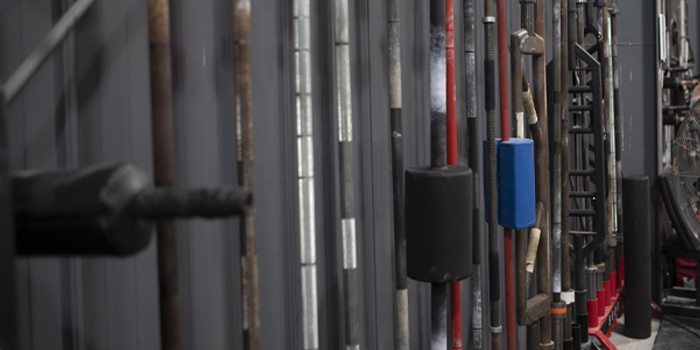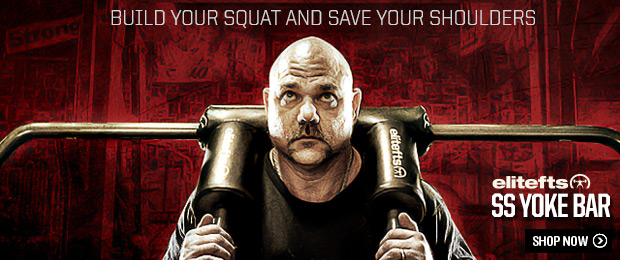
There are an astonishing amount of ties between powerlifting and the tactical world. I have learned more about things I could do differently in training troops in the past three years of conjugate-based training than I learned the entire decade prior. The idea of specialty bars never even occurred to me, nor had I heard of them. I was hell-bent on being the toughest, fastest, and leanest machine around, but I was using an axe to chop toothpicks. I was using HIIT training, death runs, intense Crossfit WODS, sprints, ruck runs, and power cleaning to develop “explosive power” several times a week.
Had I been a little smarter or open-minded, I would have realized that the trap bar is a useful tool and has its place. Maybe I would have saved a few years of pain. If I had not been so hard-headed and realized a giant cambered bar is a phenomenal tool for building up the posterior chain, I believe I would have been hopping up mountain edges like a young mountain goat. Had I learned that the American Multi Grip cambered bar even existed, I could have saved a few years of wear and tear with the opposing forces of a ruck pulling my shoulders back.
Why Use Specialty Bars?
Using the appropriate tools over these past few years has helped me discover that just because you have to train minimally when deployed to austere conditions, it does not mean you should not take advantage of the specialty equipment when you are back stateside. If there are a few things I have learned throughout devouring dozens of Conjugate articles from elitefts, Matt Wenning, and almost all of the Westside Barbell publications, it is that almost every bar has its place.
Some bars are better for my style and my views of what the tacticians should be training with, and some are quite literally made for the monsters squatting in the quad digits. Certain specialty bars almost feel like they are taking mileage off of my body the way Cameron Frye wished driving in reverse did. It feels as though for the first time in a long time, I am getting more out of an exercise than I have to put into it.
I have spent a lot of road time with a ruck and vest, most of it running. I have solved a lot of problems just by getting some fresh air and thinking things through. But one thing I never thought about was how I could train differently. Around the compound I worked on, everyone was in some level of pain. Any number of people were out having surgeries, recovering from surgeries, or just flat out nursing years-old injuries that will not get better with time alone. For some reason, we all just accepted that it was “part of the norm” and “the tax” we all paid to be where we were. Had I put any thought into what I could do to make a difference, I think some of my comrades would be in better positions today.
Worthy Specialty Bars
Safety Squat Yoke Bar
First up is the Safety Squat Yoke Bar. The Safety Squat Yoke Bar is a phenomenal tool that may as well have been made for military personnel. This tool can be used for loaded carries, squats, lunges, and many other variations that displace the load in an ultra-high bar position, which places a great demand on your core strength. If you have a weak core, this Yoke Bar will bring it out of you. Another tool to consider is to also grab some Spud Inc Swing Set (yoke carry) straps and place them on the SSYoke, you will be working so many different muscles in such a short amount of time, no clime or place will give you a challenge.
PRO TIP; drop the weight by 40-50% and “flip” your yoke around when doing carries so the “SSYOKE” is facing your neck instead of away from you. The added stimulus will challenge your bracing technique and stability under load. Every critical responder could use more of that.
Trap Bar
Next is the Trap Bar, regarded by Mark Rippetoe as a “useless piece of junk”, which has done wonders with instructing young athletes, first responders, and military members on bracing techniques, loaded carries, and variability in training. I struggle to call this a specialty bar because I believe it is necessary for every gym hosting first responders. For all intents and purposes in my gym, we are training to be stronger overall, emphasizing emergency response capabilities. In my opinion, this specialty bar adds greatly to the training stimulus and capabilities of everyone here.
Giant Camber Bar
Then we have the Giant Camber Bar (or the Spider Bar, depending on your age and how much mileage you have, which would serve the same general purpose) is the ultimate core and posterior chain builder. These specialty bars get a little pricey but are well worth their investment. I have recently discovered how much I have been missing this bar by a recent visit to Westside. The coaches there, namely Tom and Mac, showed me how weak my hips and glutes are compared to the remainder of my posterior chain.
This bar lights everything up with its instability. Especially with box squats when you are using more of your posterior chain on your way up, this will light a fire that you will never forget. The instability when training with this bar translates directly to navigating your way through unstable or inclined terrain. This bar points out weaknesses that are difficult to see compared to a traditional barbell.
Marrs Bar
The Marrs Bar is very expensive- but worth every pretty penny. I will be the first to say it. But it is absolutely irreplaceable in our gym. For good mornings alone this has changed my capabilities as an athlete. I can now complete good mornings more than once a week without dramatic recovery time or horrible pain. Due to several back injuries sustained, I was unable to complete traditional standing good mornings without extreme sciatica and shooting pain down my left leg. Seated good mornings were still a go, but no more standing. With the weight displaced to an “ultra-low position”, I am able to hit very heavy (relative) 3-5 rep maxes on standing good mornings with zero pain.
The “hands-free” capability this bar has, allows you to have significant overload sessions in Hatfield squats or other variations, which will help you receive your ruck and even help you wear your ruck better.
Multi-Grip American Cambered Bar
Equally important is the Multi-Grip American Cambered Bar. There is no doubt that bench press is a great metric used to measure overall upper body strength. This has been brought up by not only the powerlifting community but also people who have been serving the tactical athlete community for decades, such as Rob Shaul. This specialty bar is a phenomenal tool for addressing upper body weakness while being a bit friendlier to your wrist, elbow, and shoulder joints. The angled grips allow you to put your hands in a position that you are more likely to use in the real world, such as grabbing an individual to remove them from a dangerous situation.
If you have nagging shoulder issues and you do not want the added range of motion, there are many other flat multi-grip bars available, but you can also flip the American Multi-Grip bar over to use as its own built-in board press.
Earthquake Bar
The final specialty bar I would like to bring up is the Earthquake Bar. I will admit, when I first saw it I was extremely skeptical. I thought “What the hell, I can just hang bands from a bar and get the same effect!”. But after I first tried it, I was sold. The displacement of the weight is dramatically different hanging from a six-pound bar versus a 45-pound bar. This bar has worked magic for my shoulders and stability work. I wish I was smart enough to explain it, but just send an email to the owner, original Westside member, and bodybuilding legend Jim Seitzer. Seitzer can explain it in terms I can not.
Before implementing this bar, I never felt truly stable on the bench and I always felt like something in my rear delt was going to tear. Turns out, this bar helped me build a better “platform” with my back. The first few times I used it on the bench press, my rear delts and back were sore all along my erectors. I simply did not understand how much back was involved in the bench press until the earthquake bar was introduced in my gym.
Why I am Pro Specialty Bars!
Specialty bars should have a monumental place in the first responder community. They are a significant financial investment, but one worth their weight in whatever precious metal you can think of. From personal experience, without Westside Barbell, Bandbell, or elitefts and their specialty bars, I am not sure I could chase my son around after my retirement. You can’t put a dollar sign on that.
Originally from Detroit, Michigan, Chris Key joined the military to find a life worth living and quickly found his passion in Explosive Ordnance Disposal and supporting the Infantry. After separating from active duty, he ran into a litany of physical ailments —spondylolisthesis, spinal stenosis, ligament tears, bilateral meniscal tears, sleep apnea, and mental health disturbances. He then transitioned to support the military and first responders in a different way by trying to increase the health and longevity of military and first responder personnel. His credentials include completing the Special Operations Support Orientation Course (EOD Tech), Marine Corps Instructor of Water Survival, EMT/Advanced EMT, and various other military specialized courses. He is currently working on an ambulance while attending school to become a Physicians Assistant.











2 Comments